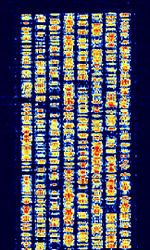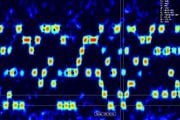Automatic Link Establishment (2G ALE)
2G ALEAutomatic Link Establishment - 3G ALE - ALE-400
Automatic Link Establishment, 2G ALEAutomatic Link Establishment (Official designation MIL-STD-188-141A and/or MIL-STD-188-141B (Appendix A)) is the current standardized method of establishing connections between radio operators. Also known as FED-STD 1045, FED-STD 1049, and STANAGNATO Standardization Agreement (STANAG), defines processes, procedures, terms, and conditions for common military or technical procedures or equipment between the member countries of the North Atlantic Treaty Organization (NATO). 5066. Although an improved protocol exists (3G ALE), the vast majority of ALEAutomatic Link Establishment systems in use in the world at the present time are 2G ALEAutomatic Link Establishment.
Characteristics[edit]
2G ALEAutomatic Link Establishment uses 8 tone MFSKMultiple Frequency Shift-Keying at 125 bdBaud (unit symbol Bd) is the unit for symbol rate or modulation rate in symbols per second. with 250 HzHertz (Hz), unit of frequency, defined as one cycle per second (1 Hz). shifts between tones for a total bandwidth of 2000 HzHertz (Hz), unit of frequency, defined as one cycle per second (1 Hz).
Operation[edit]
To reach a specific station, the caller enters the ALEAutomatic Link Establishment Address. On many ALEAutomatic Link Establishment radios this is similar to dialing a phone number. The ALEAutomatic Link Establishment controller selects the best available idle channel for that destination address. After confirming the channel is indeed idle, it then sends a brief selective calling signal identifying the intended recipient.
When the distant scanning station detects ALEAutomatic Link Establishment activity, it stops scanning and stays on that channel until it can confirm whether or not the call is for it. The two stations' ALEAutomatic Link Establishment controllers automatically handshake to confirm that a link of sufficient quality has been established, then notify the operators that the link is up.[1]
Video Examples[edit]
Frequencies[edit]
- ALE Amateur Radio Frequencies
- Utility World ALE Frequency List
- USAF High Frequency Global Communications System (via UDXF - PDF)
Decoding Software[edit]
- Hobby Level Software
- ALE decoding for the IPhone / IPad
- Black Cat ALE (MacOS and Windows versions available)
- MARS ALE downloads and forum
- MultiPSK (In MultiPSK, this signal is designated as "141A (ALEAutomatic Link Establishment)")
- Multimode (Mac software)
- PC-ALEAutomatic Link Establishment - can be found on the HFLink Software page
- Sigmira as of release 1r12
- Sorcerer
- Professional Equipment/Software
- go2DECODE
- go2MONITOR
- Hoka 300-32
- ION2G Selective Calling
- Krypto 500
- Wavecom W-Code
- Wavecom W-Spectra
Additional Links[edit]
- 2G ALE Waterfall
- United States Department of Defense MIL-188-141B
- ALE Information file (PDF) from the UDXF website
- International Amateur Radio ALE Channel List
- Utility World 2G ALE
- HFLink.org is the primary resource and international frequency coordination entity for Amateur Radio ALEAutomatic Link Establishment Automatic Link Establishment. The most current versions of the popular freeware PC-ALEAutomatic Link Establishment can be found here
- PC ALE Forum
- shoc Database: 2G ALE
- WAVECOM Database: 2G ALE
- MultiPSK 188-141A ALE
- ION2G Selective Calling
Additional Images[edit]
|
|

